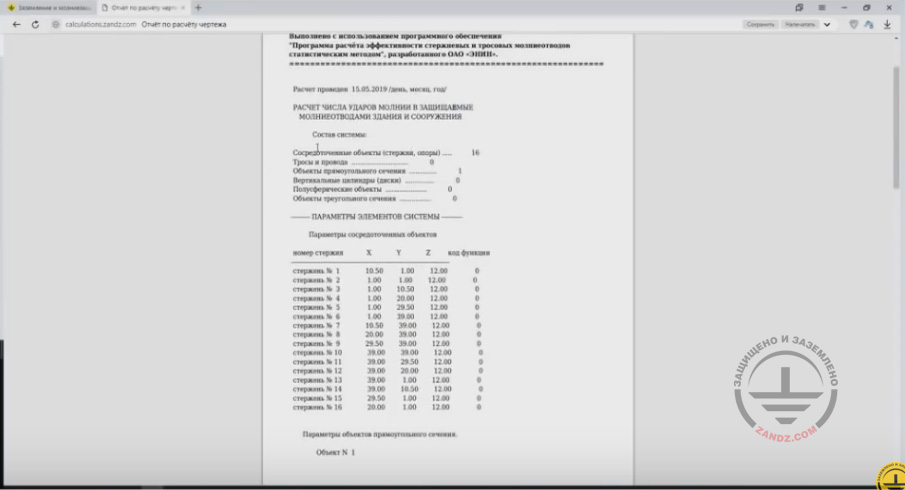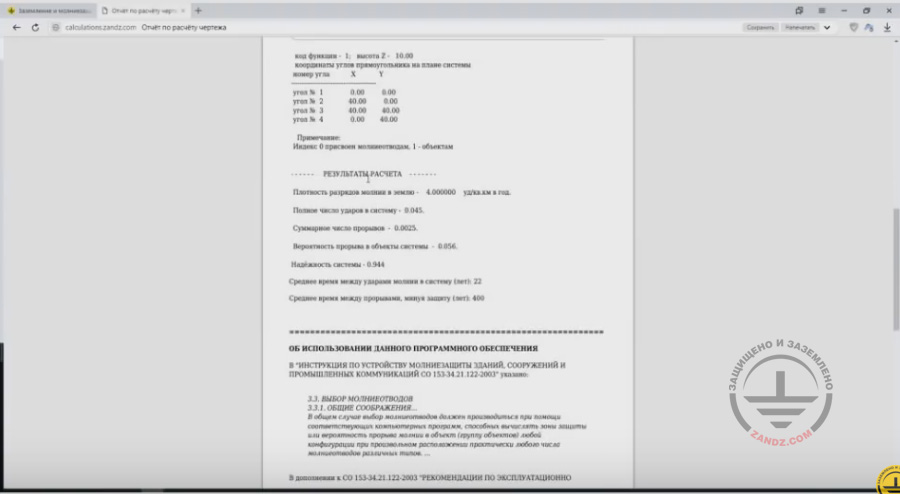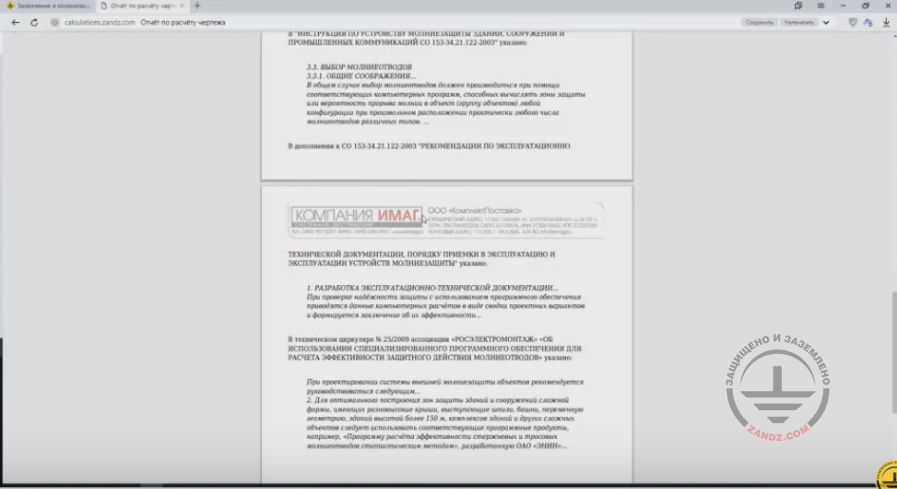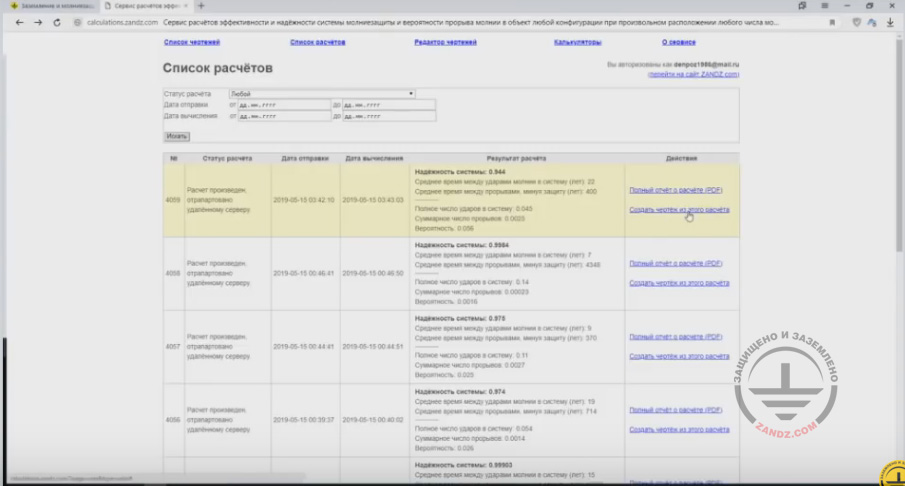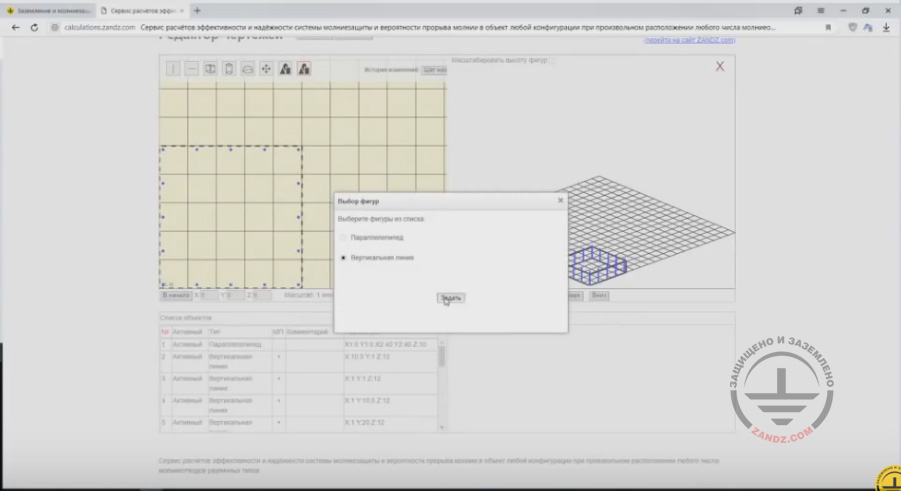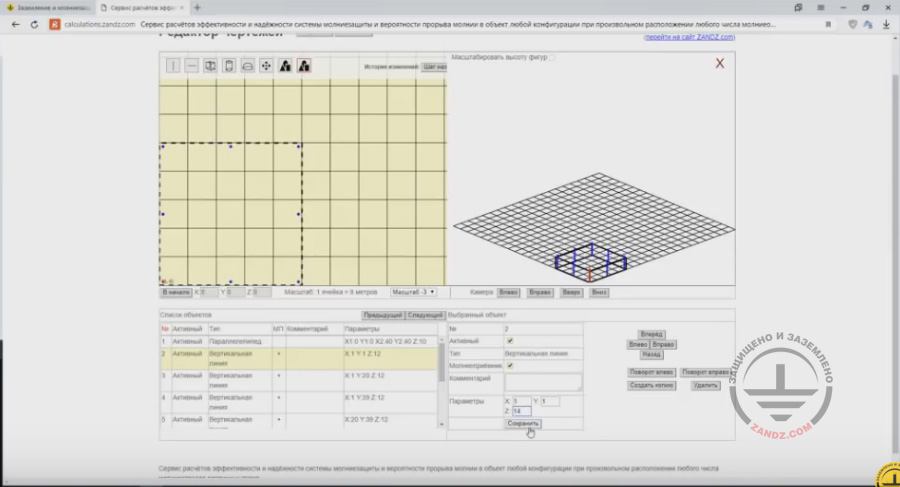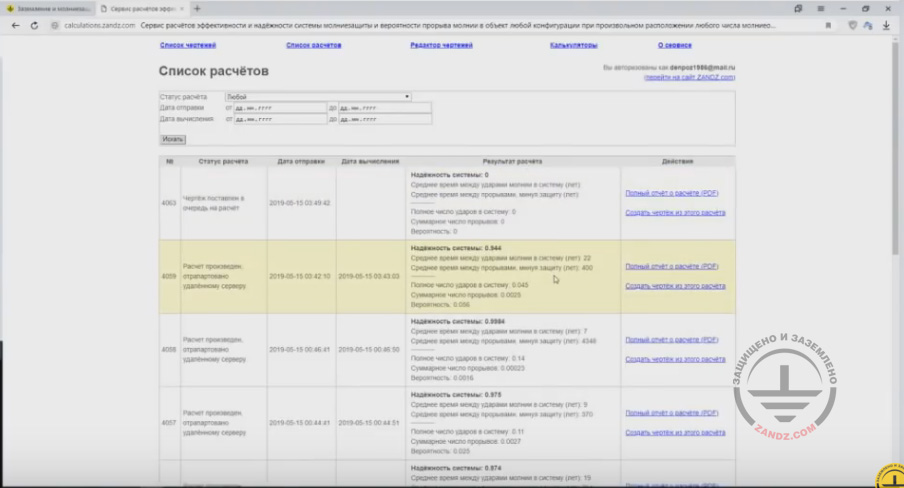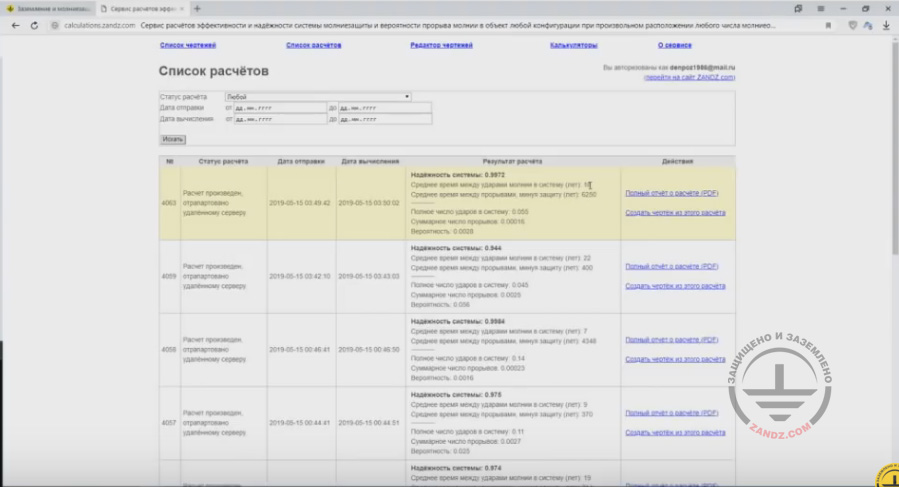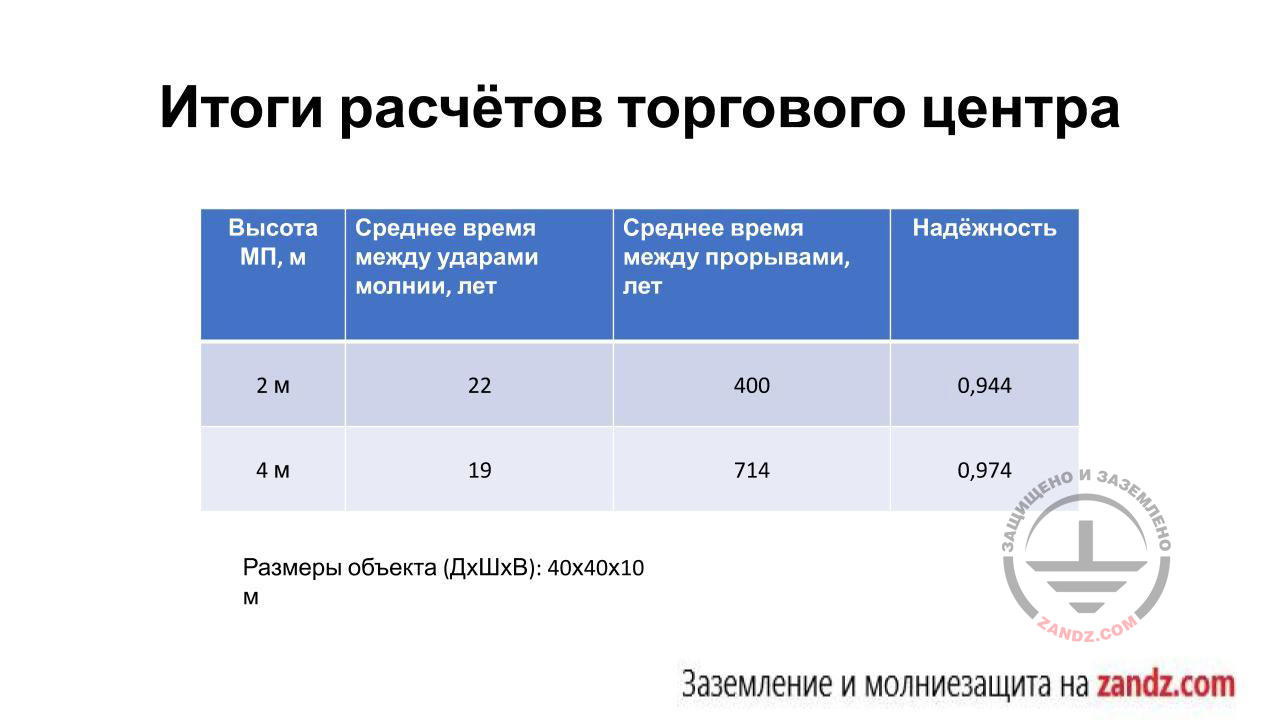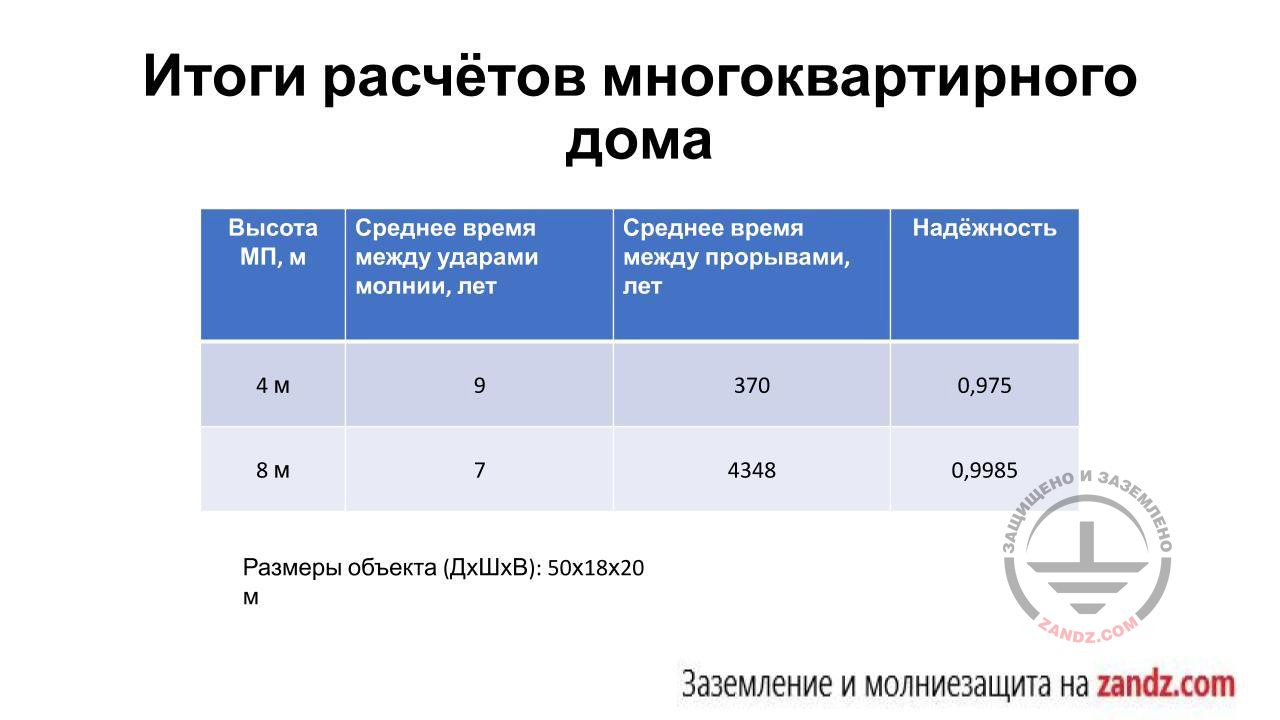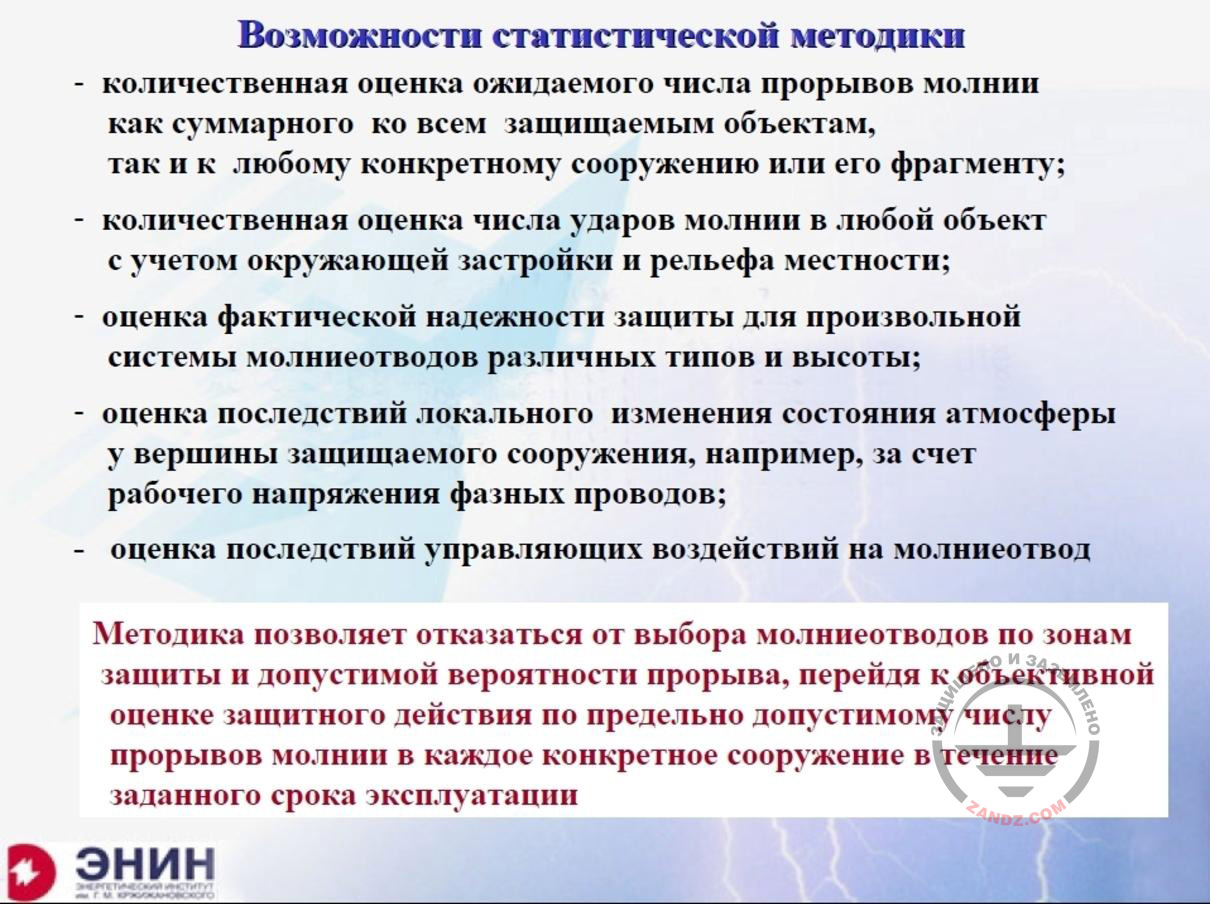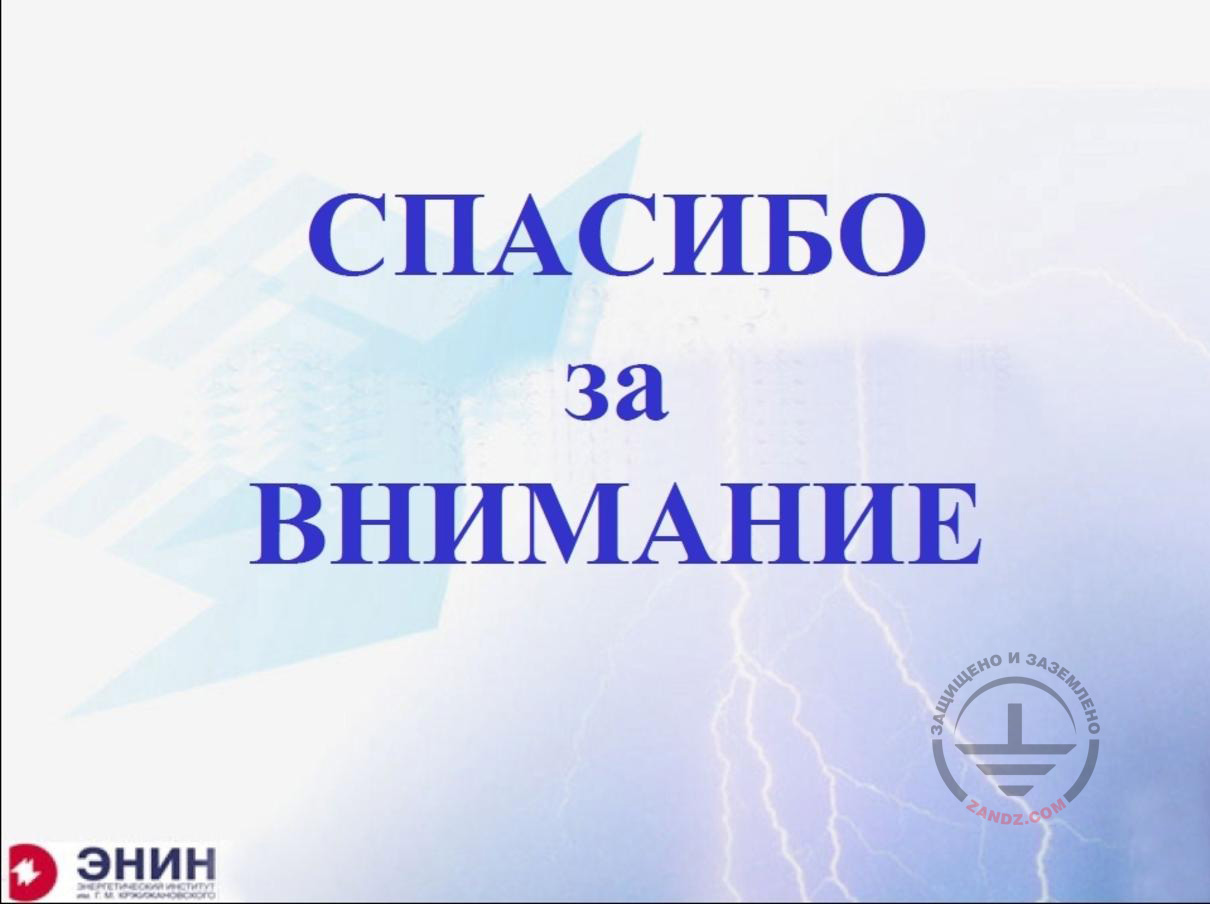Webinar text. Page 3
Fast navigation by slides:
1. Why do we need more than protection zones?
2. Choosing lightning arresters
3. Transition to multi-electrode protection systems
4. Regulatory base
5. "Group" action of lightning arresters
6. Multi-wire lightning protection
7. What problems do protection zones for lightning arresters entail?
8. How to define zone dimensions?
9. Probabilistic technique, ENIN modification
10. Determining the lightning strike of the lightning channel
11. Technique background
12. Formulas
13. 3 calculation parameters of the technique
14. Software for calculating reliability
15. How to access the calculation service?
16. What examples will be considered?
17. Drawing editor
18. Screen demonstration
19. Information on calculation service
20. Object description
21. Square object
22. Entering accurate dimensions
23. Object coordinates
24. Shape sizing
25. Drawing lines
26. Mast coordinates
27. Demonstrating the "Lightning Protection Density" window
28. Calculations
29. Calculated by
30. Saving a report
Page 3:
31. Brief system composition
32. Calculation result
33. References to regulatory documents
34. Demonstrating the "Calculation List" window
35. Previous calculation results
36. Removing unwanted elements
37. Saving a drawing
38. Calculation list. Displaying results
39. Calculation list. Calculated by
40. Results of calculation for a mall
41. Results of calculation for a multi-apartment house
42. Thank you!
43. Weak points in the statistical technique
44. Questions and answers
45. Features of the statistical technique
46. Thank you!
A brief system composition
What is it? Brief composition of our system: What have we added? What objects do we have? In our case, we have added "rods", i.e. our lightning arresters, and we have also added a rectangular object, i.e. this is the mall. The coordinates for all objects have been briefly described, i.e. these are our lightning arrester coordinates, the coordinates of the mall.
Calculation results
References to regulatory documents
At the end of the report, the references to the regulatory documents that allow using this software are provided. Eduard Meerovich had time to tell this, this is Technical Bulletin No. 25/2009. Moreover, there is information provided in SO-153, Clause 3.3.1, stating that the calculation is generally performed in the software. Since formulas provided in the regulatory documents, do actually cover single and double lightning arresters only. Let's get back to our service. Press "back" in the window to do this.
Demonstrating the "Calculation List" window
Let's try to calculate this object using only lightning arresters of 4 meters high. To do this, we press "Create a Drawing" from the calculation.
Let's see how we can change heights of our lightning arresters. Anatoly, I can see that Eduard Meerovich has joined the webinar.
– Yes, colleagues. Eduard Meerovich, you have returned!
– Yes, we have power again and we are listening to you attentively, and we are ready to answer questions if there are any for me.
– Eduard Meerovich, I have a proposal. I suppose that Denis does not have much information before the end of the presentation.
– Yes, good, I am listening to it attentively.
– Great. Then Denis will finish his report and a Question and answer part will begin.
– OK. Fine.
Previous calculation results
Let me, to make it short, show you the calculation results that have been preliminarily performed. We will perform the second calculation for the mall and then go to the end. So, we have returned to the drawing that is already saved, which is present in our drawings list. What can we do? We will remove our lightning arresters that will be excessive, i.e. we will leave masts in the edges and in the center, make them 4 meters high, and remove all intermediate ones. To do this, we have two options. We can directly choose an object in the workspace. Let's choose the lightning arrester and see that we can choose either our 3D box or our vertical line in this point. We choose the vertical line and delete it. Thus, we can remove all of these masts we do not need. We choose a vertical line each time. And the masts we do not need will be removed and their height will be changed from 2 to 4 meters.
Removing unwanted elements
We have removed the unnecessary elements, but masts in the edges and in the center are left. So, we can now do that from the object list. Choose them and change their height directly by changing it in the Z coordinate. It means that, in our case, we change the 2 meter high lightning arresters to 4 meter high, so we change them from 12 to 14.
Save a drawing
After that, save the drawing by pressing "Save". And in the "Drawings List", this drawing will be shown separately, i.e. the previous one is saved, and we can get back to our previous configuration. So, press "Calculate" then.
Calculation list. Results display
And we go to the calculation list again, i.e. this is our previous calculation and we are waiting for the new one. I will update the page now, and we will display all results on the screen.
Calculation list. The calculation is done
The calculation has been performed, i.e. we can see that by increasing the lightning arrester height, we can provide a higher reliability. However, the average time between the lightning strikes into the system will be once in 22 years instead of 18. This is what I have already talked about. This is the meaning that defines the number of lightning strikes into the system in general irrespective of the lightning arrester or the object. So, the lower the value, the more often the electromagnetic interference will occur due to the direct lightning strike.
Results of calculation for a mal
Итоги расчетов торгового центра - Results of calculation for a mall
Высота МП, м - LA height, m
Среднее время между ударами молнии, лет - Average time between lightning strikes, years
Среднее время между прорывами, лет - Average time between breakthroughs, years
Надёжность - Reliability
2 м - 2 m
4 м - 4 m
Размеры объекта (ДхШхВ): 50x18x20 м - Object dimensions (L x W x H): 50 x 18 x 20 m
Let's get back now to the presentation and sum it up. For the mall, we have performed two calculations using 2 and 4-meter lightning arresters. We can see that with the increase in lightning arrester heights, the reliability improves and the average time between the breakthroughs to the object that pass the lightning arrester system is increased. However, the number of lightning strikes to our system in general becomes lower. We will not hold up Eduard Meerovich and go to the calculation results for the multi-apartment house.
Results of calculation for a multi-apartment house
Итоги расчетов многоквартирного дома - Results of calculation for a multi-apartment house
Высота МП, м - LA height, m
Среднее время между ударами молнии, лет - Average time between lightning strikes, years
Среднее время между прорывами, лет - Average time between breakthroughs, years
Надёжность - Reliability
8 м - 8 m
4 м - 4 m
Размеры объекта (ДхШхВ): 50x18x20 м - Object dimensions (L x W x H): 50 x 18 x 20 m
Let me remind you that its dimensions are 18 x 50 meters and the height is 20 meters. We have doubled them and obtained the following results. When we use the 4-meter high lightning arrester, the average time between the lightning strikes is once in 9 years, while with the 8-meter arresters, this value has decreased. The lightning strikes the object more often, i.e. once in 7 years. So, we can conclude that by using lower lightning arresters, we can reduce the number of electromagnetic interferences as a result of the lightning strike. So, when entering... the system, we have briefly considered it and represented it only as a rectangular object... When creating our system in the drawing editor, we have to consider all possible elements, i.e. some houses near the object, which are higher than the protected object, e.g. trees, to the maximum extent. If equipment is located on the roof: engines, chillers, etc., you also have to indicate them. And the better your protected system will be described, the better your calculations will be.
Thank you for attention!
Спасибо за внимание - Thank you for attention!
Технический центр ZANDZ - ZANDZ Technical Center
That is it. Thank you! I give the turn to Eduard Meerovich.
– Thank you very much! However, I would like to add two points. You know, when you describe the entire system, you can reproduce all adjacent houses, e.g. tall houses, but they can also be considered as natural lightning arresters.
Weaknesses of the statistical technique
Слабые места статистической методики - Weaknesses of the statistical technique
нет фактических данных для проверки результатов расчета надежности зашиты на уровне свыше 0,999; - No actual data to check the protection reliability calculation results at the level of above 0.999;
нет фактических данных для ввода зависимости высоты ориентировки молнии от величины ее тока; - No actual data to enter the lightning orientation height vs. its current;
необходимость замены реальной конфигурации зашищаемых сооружении набором элементарных геометрических фигур, для которых можно вычислить минимальные расстояния до головки канала молнии в плоскости ориентировки; - Need to replace a real-life configuration of protected structures with a set of elementary shapes, for which we can calculate the minimum distances to the lightning channel head in the orientation height;
формализованная замена процесса взаимодействия электрических полей встречных лидеров пониженным значением стандарта разброса пробивных напряжений - Formalized replacement of the process of interaction of the electrical field of the opposed leaders with the reduced dispersion standard for the breakthrough voltages
I would like to tell you one more thing. Our technique has weaknesses. I want you to know them. The point is that today, this technique allows counting the number of lightning strikes in general. The number of lightning breakthroughs in general; but it cannot count types of lightnings. And it is important for you and the customer to count dangerous lightnings. To determine, how many lightnings will have the current that leads to the object damage. Why do you need weak lightnings? And the number of lightning breakthroughs? It is important to count not all lightnings but rather only those that are dangerous in terms of their exposure power. Today, such technique cannot do that but other techniques existing today as well as the IEC technique and the protection zone can neither. All of this is oriented towards some non-specific lightnings only. And you certainly have to consider this.
I am ready to answer all questions that will follow. I understand well that it is distressing to hear that the power was not cut by the competitors but it was caused by an accident in the building; therefore I ask your pardon for interruption. I am ready to answer. Anatoly, what further questions do we have, if any?
– We have many questions, and I will begin from the start. Question from Alexey: "RD 34 and SO-153 show the protection zone shape. Are there any formulas that describe their origin and provide explanation best of all?"
– You know, we had a special webinar during which we discussed these protection zones. Anatoly, can we take this webinar from the website? Yes, sure, I will send a link. The issue is nicely described there. I can tell you how these zones have appeared. First, the protection zone shape has to be chosen. To choose, e.g. a circular zone, or it can be different, but the typical protection zones provided in RD 34 and SO-153 are the zones provided as circular cones. This is the first point. The second point is that the protection zone is considered to be filled entirely by the protected object. Although, in real life, the zone is partially filled by the protected object, but the remaining space is empty. Therefore, if you perform calculation for the lightning arrester according to the protection zone, then you will surely make it too high. The webinar I am talking about describes where these protection zones have been taken from.
– I have sent the link of this webinar record to the chat and we are proceeding to the next question: "Eduard Meerovich, why do not you mention federal norms and rules, namely safety rules for blasting operations (605)? This document also contains the rules for lightning protection and earthing devices. What do you think about it?"
– You know, the point is that I do not consider the departmental documents intentionally. There are many of them, and some of them contain the points that require a special comment. Today, we follow the Russian-wide regulatory documents. There are two such Russian-wide regulatory documents. Anything associated with the special regulatory documents, i.e. construction standards and rules (SNiPs), is a special issue. And we should say that generally these SNiPs have not passed any special professional expert review. For example, I know that some documents that hold no water. I do not know, probably the guidelines for blasting operations are not like this, although I just do not know that.
— Thank you! If a simple lightning rod within the orientation distance attracts a lightning, then why are its protection zones not cylindrical?
– The point is, I tell you again, the shape of the protection zone can by any, including cylindrical. The point is, what are protection zones and what are they defined by? It is defined only by the lightning breakthrough probability, but you cannot define the plane univalently using one value. The zone surface corresponding to this value can be different. For example, conical, cylindrical, rectangular or any shape may have particular sizes. This is a drawback of the protection zones. You know, the conical shape was traditionally taken, but it is not related to the orientation height.
— Thank you. Question: "The need to use SDPs. To what extent the risk evaluation methods provided in GOST R IEC 62305-2-2010 Risk Management. Protection Against Lightnings. Part 2. Risk Evaluation. are applied? Can we justify the need to use SDPs despite the fact that the presence of SDPs is not required in an approximation." Can you comment on this?
– In an approximation of what?
– In a first approximation, SDPs are not needed.
– The point is that I would not have transferred the risk calculation that was made in the standard IEC 62305 to the Russian soils. In Russia, the attitude to this is somewhat different for the following reason. The point is that the standard IEC 62305 was generated by the people who were interested in the maximum use of the SDPs. As far as I understand and know the trends existing in power industry, we treat SDPs as follows.
Capabilities of the statistical technique
Возможности статистической методика - Capabilities of the statistical technique
количественная оценка ожидаемого числа прорывов молнии как суммарного ко всем защищаемым объектам, так н к любому конкретному сооружению или его фрагменту; - Quantitative evaluation of the expected number of lightning breakthroughs, both total for the protected objects and for any particular structure or its part;
количественная оценка числа ударов молнии в любой объект с учетом окружающей застройки и рельефа местности; - Quantitative evaluation of the number of lightning strikes into any object with the consideration for the surrounding buildings and the terrain;
оценка фактической надежности зашиты для произвольной системы молниеотводов различных типов и высоты; - Evaluation of the actual protection reliability for an arbitrary system of lightning arresters of various types and heights;
оценка последствий локального изменения состояния атмосферы у вершины защищаемого сооружения, например, за счет рабочего напряжения фазных проводов; - Evaluation of the consequences of the local change in the atmosphere state near the protected structure top, e.g. due to the working voltage of phase wires;
оценка последствий управляющих воздействий на молниеотвод - Evaluation of consequences of managing impacts on the lightning arrester;
Методика позволяет отказаться от выбора молниеотводов по зонам защиты и допустимой вероятности прорыва, перейдя к объективной оценке защитного действия по предельно допустимому числу прорывов молнии в каждое конкретное сооружение в течение заданного срока эксплуатации - The technique allows stop choosing the lightning arresters according to the protection zones and allowable breakthrough probability by transiting to the objective evaluation of the protective action for the maximum limit of the number of lightning breakthrough into each particular structure within the specified operating period.
We have to aim at reducing the electromagnetic impact using natural means. Due to the installation of the correct height of lightning arresters, arrangement of correct drain of the lightning current to the ground, arrangement of the correct flowing of currents in the earth, and circuit shielding. And when these conventional methods do not allow reducing the danger of electromagnetic impact to the required level, it is the only point when the SDP installation is justified. Why do Russian specialists primarily share this point of view? I will explain this. You install a rather complex device in the electrical circuit. This device changes the characteristics of the circuit by means of its parasitic capacitance, i.e. due to the parasitic inductance, due to the final reliability of its functioning. And if aim only at overvoltage limitations using SDPs, the number of these devices in your circuit may be not several hundred but even several thousand. And in this case, the reliability of the system, the reliability of its functioning will be determined by this large number of foreign elements. We have to aim at reducing this number as low as possible. Therefore, our Russian approaches are aimed at this. SDPs are a very good tool, but you have to try to limit the number of these elements. This is my personal point of view, and it is the point of view currently present in the power industry, because in this industry, the standard for the SDP use has been developed recently, wherein everything I have just told you about is the essence of this standard. This is what I think about it. — Thank you! Question: "In Moscow, for the underground way, the earthing system was made. Over the exit from the underground way, there is a small structure, whereon the lightning arrester grid and the earthing circuit are installed. Question: Is there a need to combine the earthing system and the lightning protection for this structure, i.e. the underground way? If so, then how can we do it?"
– Why? I do not understand why you need this? What for do you need this?
– Tatyana, please detail what you need that for. Thus, I will ask this question one more time a little bit later.
– Or, which is even better, send this clarified question to my e-mail, and I will answer it in writing.
– Dear colleagues, I tell you that you can send the questions to the e-mail. I will write it in the chat. And all of these questions will be studied and sent to Eduard Meerovich. He will answer them. After that, we will likely plan a separate webinar wherein we will study the questions for Eduard Meerovich, and we will answer this question during the webinar. Therefore, you can write it to the e-mail or here, in the chat. We will save them and then answer. Let's go further: "Can we use this software for calculating the lightning protection for substations?"
– What is the difference of a substation from other objects? Is it in that you will calculate lightning arresters according to the protection zones for substations? Note that these protection zones have been built using this software.
– So, the answer is yes?
– Sure, you can do that.
– Question from Nadezhda: "How can we perform calculations for a multi-level pitched roof in this software?"
– This is a question not for me but rather for the main presenter. I will answer this question. You know, the point is that you can represent such a roof in the following way: as a set of horizontal conductors. And a very good result is obtained with them. If you install, e.g. these conductors with the step of 15 meters from each other, the horizontal conductors, and thus you will delineate a roof. I assure you that you will have a great calculation accuracy.
— Thank you! Denis, can you add something to this question?
– Generally, I wanted to say the same thing: that such roofs can be represented as wires.
– I had to do that many times before, and I became sure that the calculation quality will be very high.
— Thank you! Let's go further. Question from Alexander: "According to RD 34.21.122-87, the specific density of the lightning strikes to earth per 1 km2 per year is two rather than eight." This is probably a comment to the introduction. Alexander, please clarify what you mean here. One more question: "How to protect the explosive zone over a stalk or a pipe? Will the chief expert board accept the calculation performed in this software without drawing zones? If we draw zones according to RD and SO, we will require higher lightning arresters to protect an explosive zone. We, on the contrary, aim at minimizing the lightning arrester's height."
– First, let's talk about the explosive zone. Our institute had to comment on this issue due to the fact that Gostekhnadzor thought that we should include the explosive zone with this stalk into the protection zone. The point is the following. The requirement to include the explosive area into the protection zone was taken from it. If you have got a fixed structure, you have breathing in this fixed structure, and due to it, over the structure, an explosive zone exists permanently, the dimensions of which are defined by the requirements generated by the fire security department in RD 34, then this area should be included into the protection zone. You can add it to the protection zone using the approach shown by Denis as a simple spherical or semi-spherical volume, and it will be normal. But over the stalks, the explosive concentration occurs only in the course of blowing that exists for a very short time. This is either an emergency or a situation associated with the planned system repair. And then, first, this shape will have completely different dimensions that are not standardized by the fire security department. And it is pointless to add it because the probability of coincidence of these two events is very low. We have recently sent this explanation at the official level to the company that had conflicts with Gostekhnadzor.
— Thank you! Question for Denis: "Why is a middle part of the mall left unprotected? The mentioned chillers and other hardware may be installed there. One thing is to avoid drawing them here, the different thing is to install the lightning arresters there, anyway." Please comment.
– Yes, let me comment. Thank you for the question. The point is that we have represented the mall as a single object, i.e. with the dimensions of 40 x 40 meters and the height of 10 meters. So, the system has calculated the lightning breakthrough probability for the entire space, for the entire object, including its middle area. We have demonstrated the difference between high lightning arresters and lower ones. But if we will detail the system, i.e. specify chillers in the middle of the roof of the protected object, then it will be considered in calculations.
— Thank you. We had several questions about the software. I will answer them. The software is free of charge. To use the software, you only need to register. And we have a question: "Is there a version of this software or a plugin for the CAD system or AutoCAD? Do you plan to issue such plugin?"
– I can only say one thing: we need money to issue such tools. Somebody has to pay for it. There are no people who wish to pay. And the company that distributes this software almost to its cost, I suppose, this is an unique attitude to lightning protection. I have never met such a benevolence in other places. Anatoly, are there any more questions for me? I would like to ask you that if there are such questions, collect them and send them to me in writing. I will ask them in writing or we will include them to the webinar for detailed consideration, if they are similar in some way. Let's agree on this?
– Good, thank you! Eduard Meerovich has to go, so I will send the e-mail again info@zandz.ru. You can send your questions there. I repeat once again that we are planning to hold separate webinars that will contain answers to the questions intended for Eduard Meerovich.
– I would like to add one more time that when you use this constructor to make your real environment to be protected, you should consider the following thing. The real object from what you have made should not go beyond the boundaries. It must be located within this set of elementary elements. The closer they are, the better. But anyway, you must not go beyond the real elements you use, because the software will unreasonably offer too high protection reliability value. Take this into account when you do this. As we have shown, it is easy to work with the software. The result, I think, a good result, if you do not aim at one thing, i.e. if you do not aim at calculating this for any particular lightnings. This is impossible using any technique yet. Thank you again for your attention! I hope that this year, we will see each other again and discuss your concerns. Thank you very much!
– Thank you for your presentation, Eduard Meerovich! In the chat, you can see a large number of "thank you".
– Anatoly, I will comment on AutoCAD. Considering, e.g. the general plan of the protected object or several objects, the task according to which you should perform the lightning protection, in AutoCAD, you can simply take coordinates and transfer them to the software. Unfortunately, this can only be done manually so far. Thus, you can take the coordinates directly from AutoCAD, but manually, by preliminary scaling in meters.
— Thank you! Dear colleagues, let me remind you that the service is free of charge. Any person can use it who has registered for, and we are ready to elaborate it further and update. If you have any suggestions, comments, and corrections, write to info@zandz.ru This way, we can make it better. I have seen such suggestions in the chat. And we will consider them, so use it and write your suggestions. It is very important for us. Due to this, we can understand what to improve and in what direction we should go. There are several questions. I think, Denis, we will study them. "How does this software consider large terrain irregularities?"
– If we are talking particularly about the terrain, our object is usually scaled by elevations, by floors. It means that the terrain can be represented as rectangles, or semi-spheres, if needed. Take a zero elevation and, respectively, using this zero elevation, you can represent the terrain as rectangles or semi-spheres. Let it be not very precise, but you can approximately describe this terrain, if the task is to calculate the protection, e.g. for a park or an open terrain.
— Thank you! One more question: "How large is the object area that can be calculated in the software? Are there such limitations?"
– Honestly, we have not encountered them yet. I cannot see any limitations so far. Anyway, it is a technical issue. It means that the objects, figuratively speaking, 300 to 400 meters were calculated without any problems. If the software has a limitation, and if the object is extended for several kilometers, then this is essentially only a technical issue, and we can extrapolate it to infinity.
— Thank you. Dear colleagues, with regards to registration, I cannot comment on this now, because the specialists have not answered yet. In any case, if there was a problem, we will solve it, and you can do that, those of you who are not registered, a little bit later. Question: "Can we perform calculations for a water facility (an unloading dock)?"
– Please clarify the information on this object (an unloading dock). I have never dealt with this.
– A jetty.
– Oh, sure, you can do that for a jetty. The water level is taken as a zero elevation, and, respectively, the jetty can be described using the elements available in the software. It means that there is no difference whether the object is on the ground or on the water, it does not matter for the software. The most essential aspect is the object description, the lightning arrester installation, including natural ones we were talking about, and, respectively, the lightning strike density. It means that, depending on the region, you must choose the strike number value present in the region according to the maps. Regarding all the rest issues, the software will calculate it automatically.
– Dear colleagues, I have sent, once again, the general e-mail to the chat info@zandz.com indicating the subject "questions for the calculation service"; you can send all the questions. Moreover, you can send the questions for the webinar for Eduard Meerovich or Denis to this e-mail, and it is better to use "questions for the webinar".
– This is a question for developers. I do not know.
– Vladislav, if it is critical, then please write to our e-mail. We will clarify the information and answer. We are not ready to answer yet. The question about the webinar recording: yes, it will certainly be available. Conventionally, the webinars are published in several days after their holding at our website and in the YouTube channels; the recording will be available and you will be able to watch it. Dear colleagues, if you have more questions, write to the chat, because the time has almost elapsed, or to the e-mail info@zandz.com.All of these questions will be saved and studied. Let me remind you that the next webinar will be held on June 19. It will be led by Eduard Meerovich and titled "Large Object Protection. Objects Having Large Area". You can use the link to register for this webinar or even more. Our webinar is completed at this point. I will remind that you should write the remaining questions to the chat or e-mail. Thank you very much for your participation. See you next time!
– Thank you, colleagues! Have a nice day! See you soon!
Thank you for your attention!
СПАСИБО ЗА ВНИМАНИЕ - THANK YOU FOR YOUR ATTENTION!
<< Previous page
slides from 16 to 30
Related Articles:

 Lightning Protection of Large Territories: Parks, Grounds, Plant Territories. Page 1
Lightning Protection of Large Territories: Parks, Grounds, Plant Territories. Page 1
 Lightning Protection of Large Territories: Parks, Grounds, Plant Territories. Page 2
Lightning Protection of Large Territories: Parks, Grounds, Plant Territories. Page 2
 Lightning Protection of Large Territories: Parks, Grounds, Plant Territories. Page 3
Lightning Protection of Large Territories: Parks, Grounds, Plant Territories. Page 3


